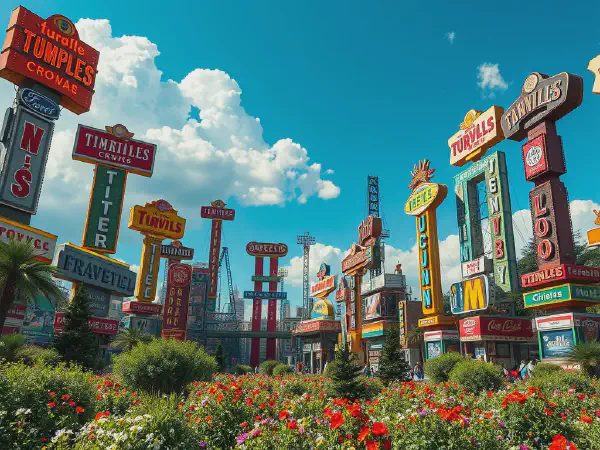Unveiling the World of Gigantic Signs: A Visual Journey

Gigantic Signs: The Monuments of Modern Advertising
Gigantic signs, towering above streets and buildings, serve as iconic landmarks in urban landscapes. These colossal installations are not only visually striking but also serve a vital purpose in the advertising realm. Gigantic signs capture attention, convey messages, and contribute to the city’s character, making them essential in both marketing strategies and cultural expressions.
Throughout history, gigantic signs have evolved from simple, painted wooden boards to intricate, high-tech structures featuring LED displays. The transformation reflects advances in design and technology, allowing companies to engage audiences in new and innovative ways. As cities expand and competition increases, the significance of these larger-than-life advertisements becomes even more pronounced.
The impact of gigantic signs extends beyond advertising; they play a crucial role in influencing consumer behavior. With their size and visibility, they can create emotional connections and brand loyalty among consumers. The use of vibrant colors, bold typography, and creative imagery make these signs memorable, ensuring lasting impressions on potential customers.
Compared to traditional signage, gigantic signs offer unparalleled opportunities for creativity and engagement. They invite interactions and experiences that smaller signs cannot provide, often becoming tourist attractions in themselves. Areas known for their gigantic signs attract visitors, adding to the economic vibrancy of the locations.
Gigantic signs illuminate the skyline, beckoning people and engaging them with brands. As a fusion of art and advertising, they continue to evolve, utilizing new technologies and design principles that resonate with contemporary audiences in a constantly changing urban environment.
History of Gigantic Signs
The history of gigantic signs begins with their origins in traditional signage, where simple painted signs announced businesses' names and services. With the advent of neon lights in the 1920s, signage evolved dramatically, leading to the first iconic gigantic signs that torched cities with vibrant colors and energy. As society advanced, so did the complexity and technology behind these mesmerizing structures.
Notable historical gigantic signs, like the 'Hollywood Sign' in Los Angeles, exemplify the significance of these designs. Originally created as an advertisement for real estate, it has become a symbol of the entertainment industry and a cultural landmark, highlighting how such signs can transcend their original purpose.
Throughout history, gigantic signs have influenced culture significantly. They have served as visual language that communicates urban identity, aspirations, and consumer values. This cultural impact is evident in various cities around the world, where gigantic signs often become synonymous with local heritage and community pride.
Design and Aesthetics of Gigantic Signs
The design of effective gigantic signs hinges on several key elements, including visual impact, readability, and creativity. Factors such as color, font, and placement are critical in ensuring that these signs capture attention and convey messages effectively. Incorporating artistic elements allows for deeper engagement and enhances the aesthetic appeal of the surrounding environment.
Innovative materials, like durable plastics and energy-efficient LED technology, have revolutionized sign-making. These advancements not only enhance the longevity of signs but also contribute to sustainability efforts by reducing energy consumption and increasing recyclability. The use of dynamic lighting and interactive features has become a norm in contemporary gigantic sign design.
Iconic gigantic signs like the Times Square billboards and the 'Welcome to Fabulous Las Vegas' sign demonstrate exceptional design principles. Their ingenuity and unique aesthetics make them part of the cultural fabric of their respective cities, often becoming landmarks in their own right and drawing tourists from around the world.
Gigantic Signs in Advertising
Gigantic signs have a profound impact on consumer behavior, often catching the eye of potential customers long before they step foot inside a store. The mere size of these signs makes them hard to ignore and can evoke emotional responses, leading to brand recognition and stronger purchasing decisions.
Strategies for using gigantic signs in marketing include location selection, engaging design, and timing for visibility. Placing signs in high foot-traffic areas enhances exposure, while utilizing bold visuals captures attention instantly. Brands often rotate messages and employ seasonal themes to keep content fresh and relevant.
Success stories abound in the realm of brands using gigantic signs effectively. Companies like Coca-Cola and McDonald's utilize their iconic signs to create a strong brand identity. Their commitment to maintaining and innovating these gigantic advertisements ensures they remain relevant and impactful within the competitive advertising landscape.
Maintenance of Gigantic Signs
Maintaining large-scale signage poses several challenges, including exposure to harsh weather conditions, vandalism, and the need for regular updates to remain visually appealing. The scale and complexity of these signs require specialized maintenance teams equipped with the necessary skills and technology to ensure their longevity.
Best practices for preserving iconic signs include regular inspections, the use of weather-resistant materials, and implementing lighting and electrical upgrades as needed. Companies often create maintenance schedules to routinely check for wear and tear, ensuring that signs remain in pristine condition.
Technological advances, such as drone inspections and smart lighting systems, have revolutionized the maintenance of gigantic signs. These innovations not only streamline the process but also enhance safety and efficiency, allowing maintenance teams to detect and address issues quickly without risking safety.
Gigantic Signs in Urban Landscapes
Gigantic signs play a pivotal role in shaping city identity and culture. They are often the first point of contact for visitors and can communicate a city's unique character and vibrancy. As urban marketers strive to create distinctive experiences, gigantic signs help define spaces and foster a sense of place.
Regulations governing gigantic signage vary from city to city, reflecting the need to balance commercial interests with aesthetics and public safety. Authorities often impose rules on size, illumination, and placement to maintain the harmony of urban environments while allowing businesses to leverage these impactful advertising mediums effectively.
Future trends in urban gigantic sign development include the integration of augmented reality and interactive elements. As technology continues to evolve, these developments will enable more immersive experiences, transforming how consumers engage with advertisements and redefining urban landscapes in the process.
